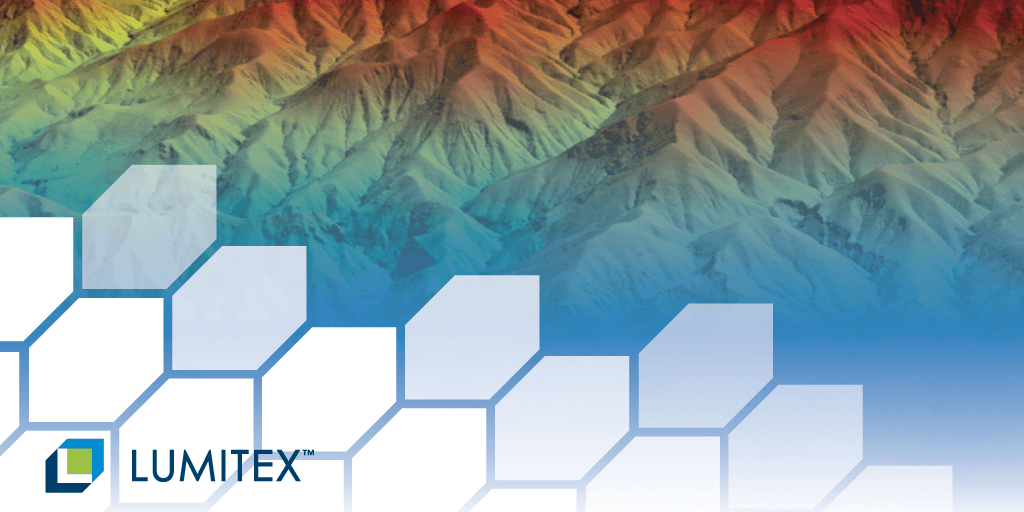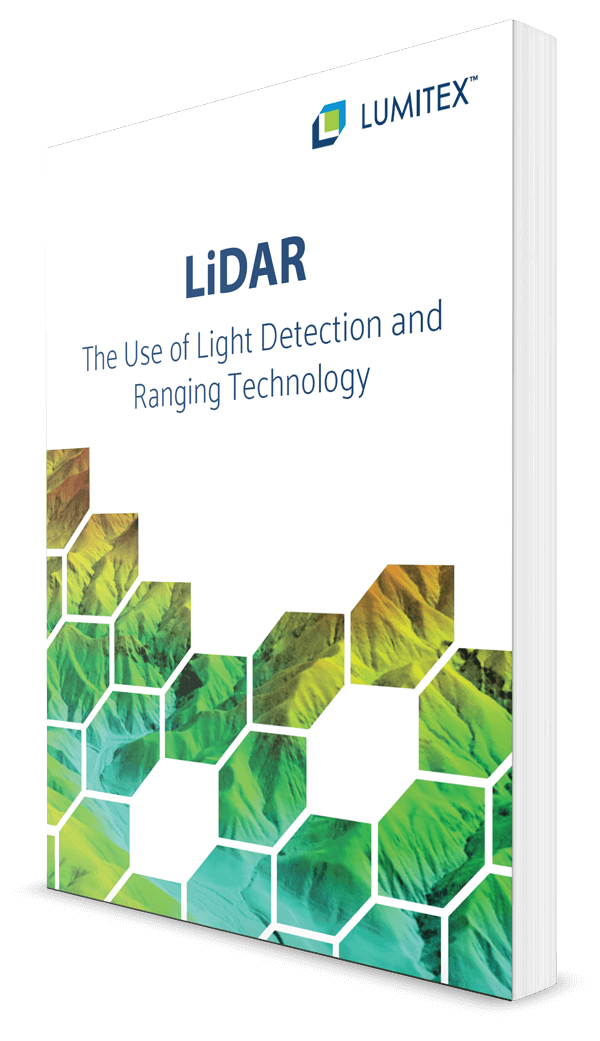
LiDAR, short for light detection and ranging, is a remote sensing technology that uses light in the form of a pulsed laser to measure ranges (distances) to a target. A LiDAR sensor fires off beams of laser light and then measures how long it takes for the light to return to the sensor.
At Lumitex, we strive to be a world-class lighting technology provider, and with that role comes the responsibility to be intimately familiar with newer applications, and to help our partners understand the true value in them. In this article, we discuss what LiDAR is, how the technology works, and its many uses.

What is LiDAR Technology
LiDAR is an active remote sensing system which uses pulsed laser beams to accurately map out an environment. The basic mechanism is known as “time of flight” measurement in which a laser beam is emitted towards an object, reflected off of the object and then collected in a sensor located within the LiDAR module. When the beam returns, it carries with it information about the object that it contacted including distance and optical characteristics like reflectivity.
It is similar to radar and sonar (that use radio and sound waves, respectively). However, it improves greatly on those traditional technologies in terms of precision of sensing. While radar can plot the location of a vehicle from miles away, the location can only be known as a featureless “blip”. While this is shown to be quite useful for roles like air traffic control, it is not suitable for the up close and personal dynamics of automobile driving.
On the other hand, the laser precision of LiDAR can visually map individual features of a vehicle or an environment in what is known as a “point cloud,” a map of individual laser measurements so densely populated that it appears on a display as solid physical objects.
Laser ranging developed back in the 1960s with terrain mapping beginning in the 1970s. One of the LiDAR platforms is aerial which is used to achieve highly detailed, local elevation data.
The true innovations behind the LiDAR units of today versus the earliest units in the 70s are in the increasing miniaturization of the electronics components, the increasing commonality of laser diodes, and the explosion of artificial intelligence and sensor connectivity over the last decade. Early LiDAR units were large, expensive, and limited to simple measurement tasks.
Today, companies like Silicon Valley startup Velodyne can offer a puck-sized LiDAR unit capable of scanning hundreds of thousands of beams per second at ranges of 100m.
How LiDAR Works
At its core, LiDAR works by sending out rapid pulses of laser light and measuring the time it takes for each pulse to bounce back after hitting an object. This “time of flight” measurement helps determine the exact distance between the sensor and the object. When this process is repeated thousands—or even millions—of times per second across a 360-degree field, it creates a highly accurate, three-dimensional map of the surrounding environment, often referred to as a point cloud.
Each of these points contains precise spatial data, allowing the LiDAR system to build a detailed and scalable model of the area—whether it's a forest, city street, or complex industrial space. Combined with positioning tools like GPS and motion sensors such as an Inertial Measurement Unit (IMU), LiDAR technology doesn’t just measure distance—it tracks movement, direction, and orientation in real-time.
Modern LiDAR systems are compact, powerful, and incredibly fast, scanning vast areas with stunning accuracy. These systems are what enable autonomous vehicles to "see" their surroundings, help engineers monitor infrastructure, and allow environmental researchers to map terrain that’s otherwise difficult to access.
Core Components of a LiDAR System
The components of the sensor system are made up of three independent operating technologies: a transmitter, receiver & detector.
1. LiDAR, laser ranging device
That sends out pulses and gives the distance or range to the target. "The laser transmits pulses and records the time delay between a light pulse transmission and reception to calculate elevation values."
2. GPS - global positioning system
Gives the location of the instrument that's holding the LIDAR sensor.
3. Inertial measurement unit (IMU)
Measures linear and angular motion.
Director of Remote Sensing, Amar Nayeganghi, explains the science and technology behind light detection and ranging services in the video below.
Dewberry, What is LiDAR? via YouTube
Data collected through LiDAR can be used in a variety of ways. The end result will be a set of data that can be used to create maps (high-resolution) and 3D models.
What is LiDAR Intensity
"Intensity is a measure, collected for every point, of the return strength of the laser pulse that generated the point. It is based on the reflectivity of the object struck by the laser pulse." [source]
There are a number of factors that affect light intensity. GISGeography states:
"The strength of LiDAR returns varies with the composition of the surface object reflecting the return. The reflective percentages are referred to as LiDAR intensity.
Range, incident angle, beam, receiver and surface composition (especially) influences light intensity. When the pulse is tilted further away, the return energy decreases."
Influences on Light Intensity
range - distance to a target
incident angle - is the angle between a ray incident on a surface and the line perpendicular to the surface at the point of incidence, called the normal [source]
beam - narrow, intense beam of light produced by a laser
receiver - detects the spectrum of light
surface composition - landscape conditions such as slope, density, and roughness
Applications or Uses for LiDAR Technology Today
LiDAR is used in a wide range of applications and across various industries. There are hundreds of applications or uses, 100 applications or uses of LiDAR technology.
We are going to focus on vehicle automation and obstacle detection in autonomous vehicles.
1. Vehicle Automation
"LIDAR is becoming more popular in vehicles to make it automatic. LIDAR is used to grab the information on the road and it is passed to computerized system to make a human being like decision. For example, LIDAR can detect the road yellow lines which tell the vehicle to stay within yellow lines. Nowadays vehicle uses Adaptive Cruise Control (ACC) which has LIDAR technology. It helps the vehicle that is in cruise control to slow down when there is a vehicle in the front and also speed up when there is no traffic. [source: Grind GIS]
In 2014, SAE published a classification system defining the capabilities of an autonomous vehicle. Today, vehicles are available with Level 2 or “Partial Autonomy” allowing the vehicle to control acceleration and steering for ADAS functions like lane keeping and adaptive cruise control.
As vehicle autonomy progresses towards Levels 3, 4 and ultimately 5 the capabilities of LiDAR in combination with artificial intelligence will expand to include object detection/classification and split-second reaction control of the vehicle. In Level 5 autonomy, the vehicle will need no intervention from human occupants. The path to Level 5 will require more and better sensors (including LiDAR) and more robust AI.
"The autonomous vehicle industry has benefited more from LiDAR than any other industry. Today, there are more and more autonomous vehicles on the road and each of these depends on LiDAR technology to move and avoid collision with obstacles on the road." [source]
2. Obstacle Detection in Autonomous Vehicles
"This is probably one of the biggest uses of LiDAR technology in the recent past. Autonomous vehicles use LiDAR technology to sense obstacles in their paths and to avoid collisions with other obstacles or vehicles on the road."
3. LiDAR holds the key to a future of autonomous mobility
According to 3D Laser Mapping, a leading provider of 3D technology, "Manufacturers are using smaller, lower range LiDAR scanners to help navigate autonomous vehicles."
An Introduction to LiDAR: The Key Self-Driving Car Sensor
The Future of LiDAR for automotive applications
Looking at the automotive industry, it can advance roadway safety, prevent car crashes, and save lives.
Conclusion
LiDAR has proven itself to be invaluable in the rapidly growing field of autonomous mobility, and its increasing adoption suggests these powerful sensors will become even more accessible in the years to come. But autonomous vehicles are just the beginning—LiDAR technology holds enormous potential across industries like healthcare, agriculture, environmental science, and infrastructure.
Do you have a project in need of LiDAR integration or precision light delivery?
At Lumitex, we specialize in custom lighting technology and optical solutions—from phototherapy systems and surgical lighting to backlit human-machine interfaces and light-based sensor integration. Our team supports every step of the process, from concept development and prototyping to regulatory-compliant production.
Let us help you bring your vision to life with advanced lighting solutions tailored to your application needs.
Frequently Asked Questions
Why is LiDAR important for autonomous vehicles?
LiDAR helps autonomous vehicles "see" their surroundings by generating precise, real-time 3D maps. It enables obstacle detection, lane recognition, and safe navigation without human input—making it essential for developing higher levels of driving autonomy.
What is LiDAR used for?
LiDAR is used in a wide range of applications including autonomous vehicles, urban planning, environmental monitoring, agriculture, archaeology, and disaster management. Its accuracy and detail make it ideal for creating high-resolution maps and 3D models.
How accurate is LiDAR technology?
LiDAR systems can measure distances with sub-centimeter accuracy depending on the quality of the equipment and conditions, making it one of the most precise mapping tools available today.





Comments